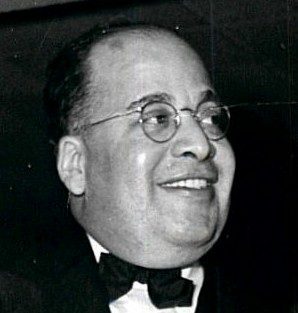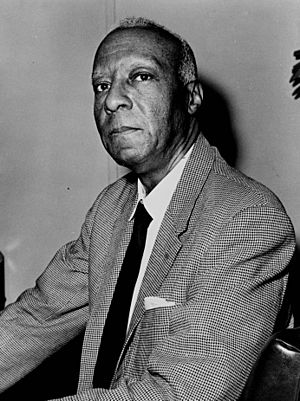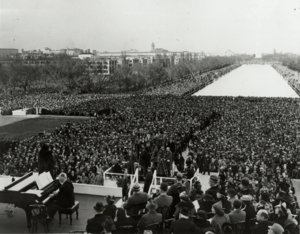National Negro Congress facts for kids
The National Negro Congress (NNC) was an organization of African-American people that existed from 1936 to about 1946. It was created at Howard University to bring many different groups together. Their main goal was to fight for the rights and freedom of Black people. The NNC took over the work of an earlier group called the League of Struggle for Negro Rights.
The idea for the NNC came from members of the American Communist Party. However, the NNC was designed to be a large coalition. This means it included people with many different beliefs. Civic groups, civil rights leaders, labor unions, and church groups all joined together. They were united by the practical goal of getting better rights and jobs for African Americans.
The NNC was formed during the Great Depression, a time when many Americans lost their jobs and faced great hardship. This crisis was even worse for African Americans, who faced higher unemployment and unfair treatment. The NNC stood against war, fascism (a type of government with total control), and all forms of discrimination, especially based on race.
At the time, many Black workers were kept separate from white workers and were treated unfairly. To fight back, they needed to form unions, which are groups that protect workers' rights. But most unions at the time only allowed white members. This left Black workers without protection. Leaders like John P. Davis and James W. Ford created the NNC to unite organizations and fight this discrimination. They believed that the struggle for fairness was not about one race, but about people of all backgrounds working together.
Contents
History of the NNC

The National Negro Congress was created because of the long history of hardship that African Americans faced in the United States, especially at work. The NNC fought against racism and unfair economic practices in many areas of life.
The group worked with labor unions, the Communist Party, and other civil rights groups. This allowed them to use the skills and resources of many different people. The NNC's work created a plan that future Black activists would follow.
The NNC included thinkers from Howard University, community leaders, and religious groups. White people were also welcome to join. Black workers in the NNC pushed to be included in larger, more powerful unions like the CIO (Congress of Industrial Organizations). The CIO supported the NNC's fight for civil rights. However, the NNC's connection to communism caused problems between the two groups.
This led to a split. Some people supported communism because it fought for workers' rights, while others only wanted to focus on civil rights. When the NNC lost the support of big unions like the CIO and the AFL (American Federation of Labor), Black workers were once again left out. The NNC became a place where they could discuss their struggles.
Fighting for a Fair Deal
When Franklin D. Roosevelt was elected president, he started a series of programs called the New Deal to help the country recover from the Great Depression. Many African Americans in the North were hopeful.
However, these programs often ignored the problems Black people faced. The NNC's co-founder, John P. Davis, noticed that no one was representing African-American interests in the government's recovery plans. He and his friend Robert C. Weaver started the Joint Committee on National Recovery in 1933. They became the first full-time lobbyists for civil rights in American history. They traveled through the South to investigate unfair treatment and poor working conditions for Black Americans.
Because many African Americans in the South were unfairly prevented from voting, the powerful Southern politicians in Congress only represented the interests of their white voters. This led Black communities to form their own groups, like the NNC, to fight for their rights.
Race, Unions, and Politics

The NNC was formed so that oppressed people could stand up to the government. A key idea was self-determination, which meant taking control of their own futures. At the first NNC meeting in February 1936, the goal was stated clearly: to build "overwhelming mass pressure and force" to fight the dangers Black people faced.
The main leader, A. Philip Randolph, was a powerful organizer. He brought together socialists, communists, and thousands of everyday African Americans. By fighting against both racism and capitalism (an economic system where trade and industry are controlled by private owners for profit), Randolph built connections with white workers and thinkers. This challenged the idea of segregation.
To create change, Randolph knew the NNC had to push unions to change as well. In 1934, he asked the American Federation of Labor to remove all rules that discriminated against people based on skin color from their member unions.
Working Together Across Racial Lines
Communists believed that if Black and white workers cooperated, it would reduce racial tension. They thought that working together against common problems was better than competing with each other.
One major issue was pay. Black workers were often paid much less than white workers for doing the same, or even harder, jobs. For example, in 1936, there were about 85,000 Black steelworkers. They were often given the most dangerous jobs with terrible heat and fumes. They also faced unfair pay differences.
Some people felt the NNC was focusing too much on the political ideas of one group. A. Philip Randolph argued that the NNC should always put the needs of the Black community first. He did not want the NNC to be controlled by any political party, whether it was the Democrats, Republicans, Communists, or Socialists. He said that none of these groups put the interests of Black people first.
Randolph wanted the NNC to have a leadership that was "uncontrolled and responsible to no one but the Negro people." By staying independent, the NNC could be a true grassroots organization, where the power came from the people themselves.
Key Moments of Support

The NNC was involved in several important events where it stood up for African Americans.
- Marian Anderson's Concert (1939): The famous singer Marian Anderson was not allowed to sing to a mixed-race audience at Constitution Hall in Washington, D.C. The city was segregated at the time. After public outrage, First Lady Eleanor Roosevelt helped arrange for Anderson to sing at the Lincoln Memorial in a historic concert.
- Paul Robeson's Concert (1941): The singer and activist Paul Robeson was also blocked from singing at Constitution Hall because he was Black. The concert was moved to a larger arena. When the organizers offered tickets to the National Negro Congress to help fill the seats, some sponsors, including Eleanor Roosevelt, withdrew their support because of the NNC's ties to communism.
- Doris Miller's Recognition (1942): Doris Miller was a hero at Pearl Harbor during World War II. The NNC publicly demanded that he receive the Medal of Honor for his bravery. Soon after, President Roosevelt approved the Navy Cross for Miller, a very high honor.
- Protesting "Song of the South" (1946): The NNC organized protests against the Disney movie Song of the South. They said the film was an insult to Black people and gave a false, happy picture of life on plantations in the old South. Protesters held signs that said, "We want films on Democracy not Slavery."
Notable Members
Many important people were members of the NNC.
- John P. Davis, co-founder
- James W. Ford, co-founder
- Paul Robeson, chairman (1944)
- Max Yergan, second president
- Ferdinand Smith, member (or supporter)
- Thelma Dale Perkins, national secretary
- Revels Cayton, executive secretary
- A. Philip Randolph, member
- Harry Haywood, member
- Arthur Fauset, Philadelphia chapter president
- Ishmael Flory, Chicago chapter president
- M. Moran Weston, field secretary
- Richard Wright (author), member
- Charles White (artist), house artist for NNC Chicago
- Walter Benjamin Garland, member
- Abram Flaxer, member
- Leon Josephson, ILD head when NNC merged with the NFCL to form the CRC
- Frederick Vanderbilt Field, ILD member when NNC merged with the NFCL to form the CRC
- Manning Johnson, delegate
Merger
Around 1946, the National Negro Congress joined with two other groups, the International Labor Defense (ILD) and the National Federation for Constitutional Liberties (NFCL). Together, they formed a new organization called the Civil Rights Congress (CRC), which continued the fight for civil rights until 1956.
See also
- League of Struggle for Negro Rights
- International Labor Defense
- National Federation for Constitutional Liberties
- Scottsboro Boys
- A. Philip Randolph
- Civil Rights Congress
- Colored Conventions Movement
External sources
- http://eblackstudies.org/intro/chapter16.htm
- http://www.encyclopedia.chicagohistory.org/pages/3214.html
- http://www.blackpast.org/?q=aah/national-negro-congress
- http://www.collection.johnpdaviscollection.org/
- http://www.negroparty.com
- http://www.blackradicalcongress.org/black-congresses.html

